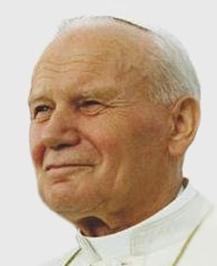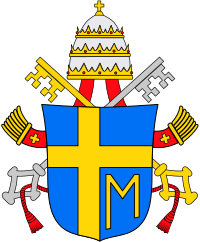Pope John Paul II
Jump to navigation Jump to search
| Pope Saint John Paul II |
|
|---|---|
| Bishop of Rome | |

John Paul II in 1993
|
|
| Papacy began | 16 October 1978 |
| Papacy ended | 2 April 2005 |
| Predecessor | John Paul I |
| Successor | Benedict XVI |
| Orders | |
| Ordination | 1 November 1946 by Adam Stefan Sapieha |
| Consecration | 28 September 1958 by Eugeniusz Baziak |
| Created cardinal | 26 June 1967 by Paul VI |
| Personal details | |
| Birth name | Karol Józef Wojtyła |
| Born | 18 May 1920 Wadowice, Poland |
| Died | 2 April 2005 (aged 84) Apostolic Palace, Vatican City |
| Nationality | Polish (with Vatican citizenship) |
| Denomination | Catholic (Latin Church) |
| Previous post |
|
| Motto | Totus Tuus (Totally yours) |
| Signature | |
| Coat of arms |  |
| Sainthood | |
| Feast day | 22 October |
| Venerated in | Catholic Church |
| Beatified | 1 May 2011 St. Peter’s Square, Vatican City by Pope Benedict XVI |
| Canonized | 27 April 2014 St. Peter’s Square, Vatican City by Pope Francis |
| Attributes |
|
| Patronage |
|
| Other popes named John Paul | |
| Papal styles of Pope John Paul II |
|
|---|---|
 |
|
| Reference style | His Holiness |
| Spoken style | Your Holiness |
| Religious style | Holy Father |
| Posthumous style | Saint |
Pope John Paul II (Latin: Ioannes Paulus II; Italian: Giovanni Paolo II; Polish: Jan Paweł II; born Karol Józef Wojtyła;[a] [ˈkarɔl ˈjuzɛv vɔjˈtɨwa];[b] 18 May 1920 – 2 April 2005) served as Pope and sovereign of the Vatican City State from 1978 to 2005.
He was elected by the second Papal conclave of 1978, which was called after Pope John Paul I, who had been elected in August to succeed Pope Paul VI, died after thirty-three days. Cardinal Wojtyła was elected on the third day of the conclave and adopted his predecessor’s name in tribute to him.[6][7] John Paul II is recognised as helping to end Communist rule in his native Poland and eventually all of Europe.[8] John Paul II significantly improved the Catholic Church’s relations with Judaism, Islam, the Eastern Orthodox Church, and the Anglican Communion. He upheld the Church’s teachings on such matters as artificial contraception and the ordination of women, but also supported the Church’s Second Vatican Council and its reforms.
He was one of the most travelled world leaders in history, visiting 129 countries during his pontificate. As part of his special emphasis on the universal call to holiness, he beatified 1,340 people and canonised 483 saints, more than the combined tally of his predecessors during the preceding five centuries. By the time of his death, he had named most of the College of Cardinals, consecrated or co-consecrated a large number of the world’s bishops, and ordained many priests.[9] A key goal of John Paul’s papacy was to transform and reposition the Catholic Church. His wish was “to place his Church at the heart of a new religious alliance that would bring together Jews, Muslims and Christians in a great religious armada”.[10][11]
John Paul II was the second longest-serving pope in modern history after Pope Pius IX, who served for nearly 32 years from 1846 to 1878. Born in Poland, John Paul II was the first non-Italian pope since the Dutch Pope Adrian VI, who served from 1522 to 1523. John Paul II’s cause for canonisation commenced in 2005 one month after his death with the traditional five-year waiting period waived. On 19 December 2009, John Paul II was proclaimed Venerable by his successor Pope Benedict XVI and was beatified on 1 May 2011 (Divine Mercy Sunday) after the Congregation for the Causes of Saints attributed one miracle to his intercession, the healing of a French nun from Parkinson’s disease. A second miracle attributed to John Paul II’s intercession was approved on 2 July 2013, and confirmed by Pope Francis two days later (two miracles must be attributed to a person’s intercession to be declared a saint). John Paul II was canonised on 27 April 2014 (again Divine Mercy Sunday), together with Pope John XXIII.[12] On 11 September 2014, Pope Francis added these two optional memorials to the worldwide General Roman Calendar of saints, in response to worldwide requests.[13] It is traditional to celebrate saints’ feast days on the anniversary of their deaths, but that of John Paul II (22 October) is celebrated on the anniversary of his papal inauguration.[14][15] Posthumously, he has been referred to by some Catholics as “John Paul the Great”, although the title has no official recognition.[16][17][18]
